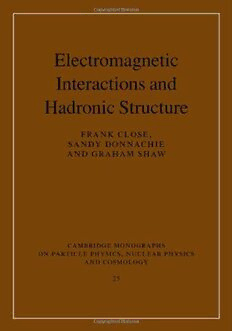
Electromagnetic interactions and hadronic structure PDF
Preview Electromagnetic interactions and hadronic structure
This page intentionally left blank ELECTROMAGNETIC INTERACTIONS AND HADRONIC STRUCTURE Thenucleiofatomsareconstructedfromprotonsandneutronsthat,inturn,arecon- structedfrommorefundamentalparticles:quarks.Thedistributionofquarkswithin protonsandneutrons,theirinteractions,andhowtheydefinethepropertiesofpro- tonsandneutrons,andhencenuclei,aresubjectsofmajorresearchworldwide.This studyrequirestheuseofbeamsofhigh-energyelectrons.Understandingofproton structure at high energies has been greatly expanded by the study of generalized partondistributionsandofnucleonspinstructure.Photonscanseparatetherolesof quarkandgluonicdegreesoffreedomwithinhadronsandhencefilterglueballsand hybridmesons.Athighenergies,bothphotonandnucleonstructurecanbeprobed. Theformermanifestsitselfindiffractivephotoprocesses,wherethereisauniquely rich interplay between perturbative and non-perturbative effects. This book pro- videsanauthoritativeoverviewonthesubject,andsectionsonchiralperturbation theory, crucial in understanding soft pions and soft photons near threshold, and dualityideas,equallycrucialatintermediateenergies,areincluded. Theemphasisthroughoutthebookisonphenomenology,andthebookconcentrates on describing the main features of the experimental data and the theoretical ideas usedintheirinterpretation.Writtenbyleadingexpertsinthefield,boththeoretical andexperimental,thisisanessentialreferenceforgraduatestudentsandresearchers inthefieldofparticlephysicsandelectromagneticinteractions. Frank Close isProfessorofPhysicsattheRudolphPeierlsCentreforTheoret- icalPhysics,OxfordUniversity.HegainedaD.PhilatOxfordUniversity,andhas workedatStanfordLinearAcceleratorCenter(SLAC),CERN,andtheRutherford AppletonLaboratory.ProfessorClosehasbeenawardedtheKelvinMedalfromthe Institute of Physics and is the author of many books aimed at both a professional andalayaudience,mostrecentlyTheNewCosmicOnion(Taylor&Francis,2006). Sandy Donnachie isHonoraryResearchProfessorintheSchoolofPhysics andAstronomyattheUniversityofManchester.SincegaininghisPh.D.fromthe University of Glasgow, Professor Donnachie has held positions at the University CollegeLondon,CERN,theUniversityofGlasgowandDaresburyNationalLab- oratory. He was awarded the Glazebrook Medal from the Institute of Physics and wasco-authorofPomeronPhysicsandQCD(CambridgeUniversityPress2002). Graham Shaw isaseniorlecturerintheSchoolofPhysicsandAstronomyatthe UniversityofManchester.HegainedhisPh.D.fromtheUniversityofLondon.He hasheldpositionsattheRutherfordLaboratory,DaresburyNationalLaboratoryand Columbia University. His many books include the well-known texts on Quantum FieldTheoryandParticlePhysics(Wiley,latesteditions1993and1997). CAMBRIDGE MONOGRAPHS ON PARTICLE PHYSICS NUCLEAR PHYSICS AND COSMOLOGY 25 GeneralEditors:T.Ericson,P.V.Landshoff 1. K.Winter(ed.):NeutrinoPhysics 2. J.F.Donoghue,E.GolowichandB.R.Holstein:DynamicsoftheStandardModel 3. E. Leader and E. Predazzi: An Introduction to Gauge Theories and Modern Particle Physics, Volume 1: ElectroweakInteractions,the‘NewParticles’andthePartonModel 4. E. Leader and E. Predazzi: An Introduction to Gauge Theories and Modern Particle Physics, Volume 2: CP-Violation,QCDandHardProcesses 5. C.Grupen:ParticleDetectors 6. H.GrosseandA.Martin:ParticlePhysicsandtheSchro¨dingerEquation 7. B.Anderson:TheLundModel 8. R.K.Ellis,W.J.StirlingandB.R.Webber:QCDandColliderPhysics 9. I.I.BigiandA.I.Sanda:CPViolation 10. A.V.ManoharandM.B.Wise:HeavyQuarkPhysics 11. R.K.Bock,H.Grote,R.Fru¨hwirthandM.Regler:DataAnalysisTechniquesforHigh-EnergyPhysics,Second edition 12. D.Green:ThePhysicsofParticleDetectors 13. V.N.GribovandJ.Nyiri:QuantumElectrodynamics 14. K.Winter(ed.):NeutrinoPhysics,Secondedition 15. E.Leader:SpininParticlePhysics 16. J.D.Walecka:ElectronScatteringforNuclearandNucleonStructure 17. S.Narison:QCDasaTheoryofHadrons 18. J.F.LetessierandJ.Rafelski:HadronsandQuark–GluonPlasma 19. A.Donnachie,H.G.Dosch,P.V.LandshoffandO.Nachtmann:PomeronPhysicsandQCD 20. A.Hofmann:ThePhysicsofSynchrotronRadiation 21. J.B.KogutandM.A.Stephanov:ThePhasesofQuantumChromodynamics 22. D.Green:HighPT PhysicsatHadronColliders 23. K.Yagi,T.HatsudaandY.Miake:Quark–GluonPlasma 24. D.M.BrinkandR.A.Broglia:NuclearSuperfluidity 25. F.E.Close,A.DonnachieandG.Shaw:ElectromagneticInteractionsandHadronicStructure ELECTROMAGNETIC INTERACTIONS AND HADRONIC STRUCTURE Editedby FRANK CLOSE UniversityofOxford,UK SANDY DONNACHIE UniversityofManchester,UK GRAHAM SHAW UniversityofManchester,UK CAMBRIDGEUNIVERSITY PRESS Cambridge, New York, Melbourne, Madrid, Cape Town, Singapore, São Paulo Cambridge University Press The Edinburgh Building, Cambridge CB2 8RU, UK Published in the United States of America by Cambridge University Press, New York www.cambridge.org Information on this title: www.cambridge.org/9780521844208 © Cambridge University Press 2007 This publication is in copyright. Subject to statutory exception and to the provision of relevant collective licensing agreements, no reproduction of any part may take place without the written permission of Cambridge University Press. First published in print format 2007 ISBN-13 978-0-511-28521-9 eBook (EBL) ISBN-10 0-511-28521-3 eBook (EBL) ISBN-13 978-0-521-84420-8 hardback ISBN-10 0-521-84420-7 hardback Cambridge University Press has no responsibility for the persistence or accuracy of urls for external or third-party internet websites referred to in this publication, and does not guarantee that any content on such websites is, or will remain, accurate or appropriate. Contents Listofcontributors pagexi Preface xii 1 Quarkmodelsofhadronsandissuesinquarkdynamics 1 1.1 Chromostatics 1 1.2 Mesonsasboundstatesfrombb¯ tolightflavours 3 1.3 Flavourmixings 7 1.4 Baryons 13 1.5 Spin–flavourcorrelations 15 1.6 SU(6)multipletsandexcitedmultiplets 17 1.7 Roleof Q2asatestofdynamics 20 1.8 Pentaquarksandexoticbaryons 24 1.9 Gluonicexcitations 28 References 36 2 Elasticformfactors 39 2.1 Electronscatteringandform-factormeasurements 40 2.2 Space-likenucleonformfactors 42 2.3 Modelcalculationsofnucleonformfactors 52 2.4 Time-likenucleonformfactors 55 2.5 Thepionformfactor 57 2.6 Theaxialformfactor 63 2.7 Nucleonstrangeformfactors 66 2.8 Outlookandconclusions 71 References 72 3 Electromagneticexcitationsofnucleonresonances 77 3.1 Issues 77 3.2 Generalformalism 80 vii viii Contents 3.3 Theoreticalmodels 85 3.4 Dataandresults 100 3.5 Concludingremarksandoutlook 130 References 131 4 Mesonradiativedecays 137 4.1 Electron–positronannihilationandτ decay 137 4.2 Single-photontransitionsbetweenmesons 151 4.3 Two-photondecaysofmesons 167 References 178 5 Intermediate-energyphotoproduction 182 5.1 Reggepoles 183 5.2 Photoproductionofpseudoscalarmesons 196 5.3 Vector-mesonphotoproduction 211 5.4 Exoticmesons 224 References 225 6 Chiralperturbationtheory 229 6.1 Chiralsymmetry 230 6.2 EffectivefieldtheoryofGoldstonebosons 236 6.3 Mesonicchiralperturbationtheory 238 6.4 Includingnucleons 250 References 268 7 Spinstructurefunctions 271 7.1 Leptoproduction 271 7.2 Structurefunctionsandcrosssection 274 7.3 Virtualphotoncrosssections 277 7.4 Symmetrypropertiesofthestructurefunctions 278 7.5 Polarizedleptoproduction 279 7.6 Thepartonmodel 281 7.7 Propertiesofquarkdistributions 286 7.8 QCDcorrectionsindeepinelasticscattering 293 7.9 Evolutionequations 293 7.10 One-particleinclusiveleptoproduction 298 7.11 Collinearpartondistributions 301 7.12 Boundsonthedistributionfunctions 303 7.13 Transversemomentum-dependentcorrelationfunctions 305 7.14 Fragmentationfunctions 307
